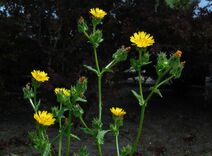Picris hieracioides
| Picris hieracioides | |
 | |
| Light: | |
| Moisture: | |
| Hardiness: | 6 |
| Soil pH: | 5.6-8.4 |
| Self Pollinated | |
| Height: | 3' |
| Width: | 1' |
| Blooms: | Mid Summer-Mid Fall |
| Meadows | |
| Native to: | |
| Edible Rating: | |
| Medicinal Rating: | |
| Tea: | Yes |
Picris hieracioides (common name: hawkweed ox-tongue) is a sun-loving forb with bright yellow flowers that are similar to dandelions. In the wild they are a good indcator plant of soil high in calcium carbonate[1] but will grow well in most dry soil[1]
Propagation: Seed - sow spring in situ, only just covering the seed. Germination should take place quite quickly.
Seed is often produced apomictically[2]. Any seedlings from this seed will be genetically identical to the parent plant.
Range: Europe, including Britain, from Scandanavia south and east to Spain, the Balkans, W. and C. Asia.
Habitat: Grassland and waysides on calcareous soils[2].
Edibility: Young leaves - raw or cooked as a pot-herb[3][4][5]. Not wonderful raw, they are slightly better cooked[6]. A rather bitter flavour[K].
Medicinal: The bitter leaves have been used as a febrifuge[7].
The plant is mixed with Swertia pedicellata and pounded to a paste thn applied to the forehead to treat headaches[8].
Pollinators: Bees, flies, self, apomictic
Soil: Can grow in light, medium, and heavy soils.
Drainage: Prefers well drained soil.
Seed Ripens: Mid Summer-Mid Fall
Flower Type: Hermaphrodite
Links
References
- ↑ 1.0 1.1 Huxley, Anthony. The New Royal Horticultural Society Dictionary of Gardening. MacMillan Press, 1992.
- ↑ 2.0 2.1 Clapham, Arthur and Tom Tootin, Edmund Warburg. Flora of the British Isles. Cambridge University Press, 1962.
- ↑ Hedrick, Ulysses. Sturtevant's Edible Plants of the World. Dover Publications, 1972.
- ↑ Grieve, Margaret. A Modern Herbal. Penguin, 1984.
- ↑ Tanaka, Tyōzaburō. Tanaka's Cyclopaedia of Edible Plants of the World. Keigaku Publishing, 1976.
- ↑ Crowe, Andrew. Native Edible Plants of New Zealand. Hodder and Stoughton, 1990.
- ↑ Chopra, R. Glossary of Indian Medicinal Plants. Council of Scientific and Industrial Research, New Delhi, 1986.
- ↑ Manandhar, Narayan. Plants and People of Nepal. Timber Press, 2002.